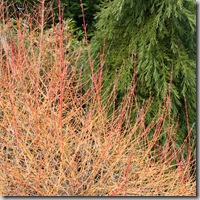 |
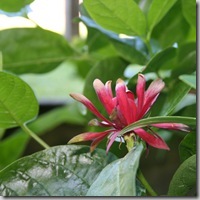 |
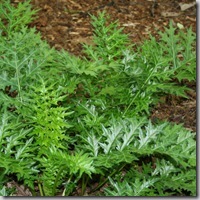 |
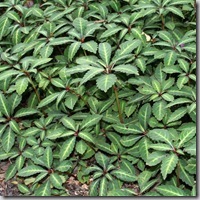 |
 |
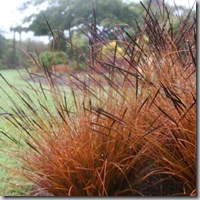 |
Gardening in soggy soil can be tough enough without the added challenge of shade. While the usual suspects in such conditions – ferns, iris, astilbe and hosta – are beautiful, if you’re looking for a more interesting or architectural planting, it can be tough to find varieties that will suit. Here are six under-used plants for shady sites that are damp or somewhat boggy.
Midwinter fire dogwood, Cornus ‘Midwinter Fire’, shines in boggy part shade. The golden stems tipped with orange stand out boldly against evergreens in winter, and in summer it’s an unassuming but attractive shrub with green foliage.
It reaches 5 feet tall and wide, and should be pruned each year to encourage lots of new stems to grow, since the new stems are the colorful ones. Simply remove 1/3 of the oldest stems at the base each year to keep it looking good.
You can use the stems you trim out in flower arrangements or by themselves in a vase for an elegant look. (Hardy to zone 5.)
Spice bush, Calycanthus occidentalis, is a California native shrub which prefers partial shade and grows to 8′ tall and wide. In full shade, its habit is slightly more twining and is a good candidate for espaliering, while in sunnier spots, it forms a sturdy shrub.
The vivid blooms have an aroma like that of a wine barrel – a fruity-musk scent with a hint of oak. The contrast between the bright flower and lush green leaf is a welcome addition to a forested area, since so many shade-tolerant plants have pastel-colored blooms. Its foliage smells spicy and herbal when crushed, a quality that deer find most unfortunate. (Hardy to zone 7.)
Spiny bear’s breech, Acanthus spinosus, has glossy deep green leaves with prickly tips. If you’re bored of the usual bear’s breech, Acanthus mollis, this is a much more interesting species that’s just as easy to grow.
It reaches 2-3′ tall and wide, and in summer, bold spikes of purple and white rise above the foliage. The blooms make long-lasting cut flowers in a vase. It’s happy in full to part shade, and looks great near water features or in urns. Just don’t plant it next to a pathway! (Hardy to zone 6.)
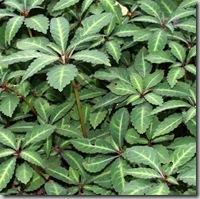 Hardy impatiens, Impatiens omeiana, is an easy, spreading groundcover with hints of red on the stems and a bold streak of variegation down the center of each leaf.
Hardy impatiens, Impatiens omeiana, is an easy, spreading groundcover with hints of red on the stems and a bold streak of variegation down the center of each leaf.
While I’ve never personally seen them bloom, rumor has it they have an orchid-like yellow blossom in late summer that highlights the creamy-gold venation on each plant.
They reach about 1′ tall, 2′ wide. (Hardy to zone 6.)
Sparkler sedge, Carex phyllocephala ‘Sparkler’, is a versatile shade plant which takes both wet and dry soil with ease. It has the look of a bamboo plant that erupted into fireworks, and what you see is just its foliage, not the flowers.
So long as it isn’t burnt by direct sunshine, the creamy-white stripes make a gorgeous show next to other variegated plants or against green or silver plants. It reaches about 2′ tall and wide. (Hardy to zone 7.)
Red hook sedge, Uncinia uncinata ‘Red’, is my new Halloween plant crush. It takes partial or dappled shade with ease, and in late summer gets these lovely brownish-black flower spikes that look all wicked next to the glossy orange foliage.
These will occasionally re-seed through the garden, but the seedlings aren’t too plentiful and are easy to pull out, so I’d consider them a benefit (free plants!) rather than a pest. 18″ tall. (Hardy to zone 8.)
Want to see what other garden designers around the country have to say? Check out the other members of the Garden Designers Roundtable who have likewise posted on the topic of shade.
Margaret Roach : A Way To Garden : Hudson Valley, NY
Andrew Keys : Garden Smackdown : Boston, MA
Christina Salwitz : Personal Garden Coach : Renton, WA
Debbie Roberts : A Garden of Possibilities : Stamford, CT
Douglas Owens-Pike : Energyscapes : Minneapolis, MN
Lesley Hegarty & Robert Webber : Hegarty Webber Partnership : Bristol, UK
Pam Penick : Digging : Austin, TX
Susan Cohan : Miss Rumphius’ Rules : Chatham, NJ
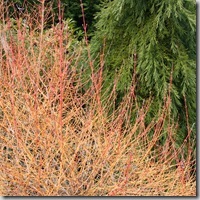
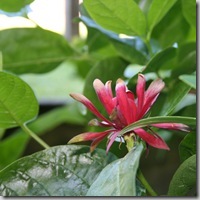
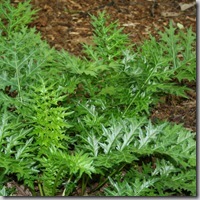
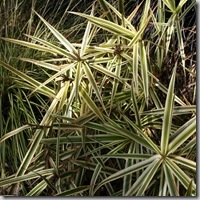
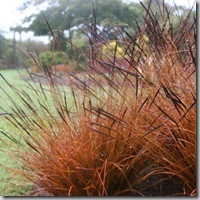
16 responses to “Plants for Damp or Wet Shade”
[…] Genevieve Schmidt : North Coast Gardening : Arcata, CA […]
Nice plants! I added Uncinia to my own shade garden two years ago (had never seen it, bought it on a whim) and it’s beautiful! It gets typical side yard conditions: all shade, then hot midday sun, then all shade again and is thriving on moderate water. I’ve been less successful with Carex ‘Sparkler’, which I added to my woolly pockets wall. It seems like at least some of the leaves are always brown, but that may just be because of the more stressful conditions I’m growing it in.
I love how thorough you are with your descriptions, Gen!
Susan, thanks so much for your experiences with these plants! I confess to having that issue you mentioned with ‘Sparkler’ sedge with all carexes – there always seems to be a little something brown happening on them. I like the sparkler sedge just because it seems easier to prune out the little deadish bits then with the finer-leaved ones, but yeah, that is an issue. It’s SO PRETTY though! (god, I’m such a sparkler fangirl)
Your Uncinia rave is one I also agree with! It just seems so refined and shiny anywhere it grows. Love it.
[…] Genevieve Schmidt : North Coast Gardening : Arcata, CA […]
Way to go tackling the damp topic! I loved your plant choices, ALL of those will live here, but that Sparkler is a tough one. Even though I’m zone 7, it’s iffy. I might have to make it a houseplant this winter. 🙂
Great work!
I’m shocked to hear you’re in Zone 7 – that explains your success with so many bright-foliaged Heucheras! They need a bit more cold than my climate can give them if they’re to last more than a few years.
Gen, About the only kinds of plants I can’t grow in my garden are moist shade plants and, of course, I find them totally fascinating. I love Acanthus spinosus, it looks like someone sprayed some kind of wax on it and polished it up in anticipation of your photo.
It does, Debbie! Like it gave itself a good old polish in anticipation of my arrival!! LOL. Too funny. Good for you for loving what you’ve got! So many people struggle and whine, then when they move, they wish they had their old conditions back. Bloom where you’re planted is a very appealing philosophy. 🙂
Wow, Gen, these are all beauties! Color AND texture is a hard combo to beat. If I had to pick a favorite, I’d go with the Sparkler sedge; what a great plant to add visual movement to a garden. Thanks for the ideas!
Oh, goody–some new plants! I love how my garden designer friends from different regions have suggestions of plants I’ve never used. We don’t tend to have too many shady/soggy areas around here, but it’s good to know I can access this info if I need to. Thanks, Gen!
As usual you put me into a tizzy of zone envy! Want, want, want the Uncinia uncinata ‘Red’. So yummy and so unlike any Zone 6 offerings!
Great approach to dealing with not one but two problems and make them no problem at all. Such a mine of info on these plants too. Didn’t no the impatiens but have grown or do grow the rest.
Fab post
Thanks SO MUCH.
Best
R
[…] Genevieve Schmidt : North Coast Gardening : Arcata, CA […]
I love that red hook sedge and just wish I had a moist, shady spot to put one in. Alas, all my shade is dry as a bone. Thanks for the link to my Sparkler sedge post. As you and Susan note, it can get some browned leaves, but I just snip them off. It really is a beautiful plant.
[…] Genevieve Schmidt : North Coast Gardening : Arcata, CA […]
I was in Connecticut last week and was so excited when visiting one of the public gardens as there in the middle was a lovely Spice Bush! And yes, I proudly declared ‘well looky here! A California native!!”…..unfortunately the only people who heard me were the nearby squirrels and frogs. Thanks for offering such fantastic alternatives to those with damp and shady gardens, Gen!